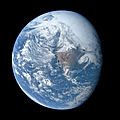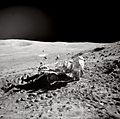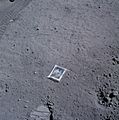Apollo 16 facts for kids
Apollo 16 was the tenth manned space flight in NASA's Apollo program. It was the 5th of six Apollo missions to land on the Moon. It was a J-Type mission, as having a longer stay on the Moon. Launched on April 16, 1972, Ken Mattingly stayed in orbit around the Moon in the Apollo Command Module, Casper. He spent 3 days, 9 hours and 28 minutes by himself, the longest solo US space flight. On the Moon, astronauts John Young and Charles Duke got to put the Lunar Roving Vehicle ("moon buggy") through a series of tests, including s-turns, hairpin turns and quick stops. John W. Young was the commander of the mission.
A satellite was launched on the return journey to examine the Moon's mass and gravitation, space particles near the Moon, and the interaction of magnetic fields between the Moon and Earth. The mission was stopped one day early as there were several problems with the spacecraft.
Images for kids
-
John Young and Charles Duke training at the Rio Grande Gorge in New Mexico
-
Young (right) and Duke training to drive the Lunar Roving Vehicle
-
Apollo 16's launch vehicle by the VAB, January 27, 1972
-
Ken Mattingly performing his deep-space EVA, retrieving film cassettes from the CSM's exterior
-
Command module Casper at the U.S. Space & Rocket Center in Huntsville, Alabama
See also
 In Spanish: Apolo 16 para niños
In Spanish: Apolo 16 para niños



















